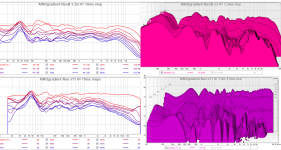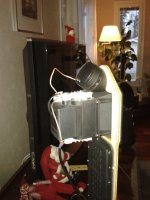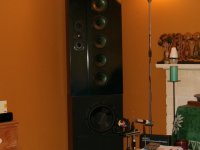I'm building a open baffle/dipole speaker and want to try a rear mounted tweeter. The problem is the only extra tweeters i have are different, similar sensitivity though. Both are 4 ohm. The amps im using are ice power amps, is it safe to wire them up in series and try it out?
I don't see why not. The tweeter combination must be preceded by a high pass filter of course.
That could be as simple as a 2.2 uF film capacitor in series with the combination.
That could be as simple as a 2.2 uF film capacitor in series with the combination.
They will have different impedance curves. You may see uneven sharing not only in level, but with response variations. It could be compensated, and you could sim that although it could be one of those situations that would make sense to try and avoid in the first place.
The fact that one of the tweeters will be rear firing introduces its own set of acoustic problems. Definitely a field for experimentation.
I believe the rear tweeter should be wired 180 degrees out of phase with the front.
I believe the rear tweeter should be wired 180 degrees out of phase with the front.
Keep up posted on this - I'd like to know your impressions on the sound, compared to, say a ribbon with the same size baffle.
Paul
Paul
Since you will only be hearing reflections from the rear tweeter, it's polarity is of little concern.I decided to buy another pair of matching tweeters to offset the problems that comes with mismatching. I'm guessing there shouldn't be problems with wiring the rear tweeter out of phase, i hope.
If you want the pair to have a dipole figure of 8 pattern (null 90 degree off axis) reversing it's polarity will roughly correspond to the woofer's polar response.
So far it isn't clear that you don't want differences, say in level and in tonal contribution.I decided to buy another pair of matching tweeters to offset the problems that comes with mismatching.
I used a rear firing tweeter of different type to the front in my bipolar speakers. I connected it using its own filter, and for polarity determinationSince you will only be hearing reflections from the rear tweeter, it's polarity is of little concern.
If you want the pair to have a dipole figure of 8 pattern (null 90 degree off axis) reversing it's polarity will roughly correspond to the woofer's polar response.
I use a 'phase flip/flop switch' that is in the form of an extension lead so I can listen to polarity difference seated in my listening position.
Believe it or not > although it's reflected sound, there IS an optimal phase orientation to be found with careful listening 🙂
Bipolar or dipolar as the OP has are two different orientations, rear response the same polarity in bipolar, rear response polarity reversed in a dipole.I used a rear firing tweeter of different type to the front in my bipolar speakers.Believe it or not > although it's reflected sound, there IS an optimal phase orientation to be found with careful listening 🙂
I certainly believe one could have a preference for one polarity over another in the reflected tweeter's sound blend with the direct, the preference seated at your listening position dependent on the distance of the ambient tweeter from the wall it reflects off.
I thought that the terms "Bipolar" and "Dipole" were interchangeable 😕 Given the above comment, what I built is DIPOLE from 600Hz to 5Khz.
There are actually 6x 5.5inch wide-band drivers in the vertical array. The lower 'Bass Box' has a front 12inch + a rear firing 15inch subwoofer.
There are actually 6x 5.5inch wide-band drivers in the vertical array. The lower 'Bass Box' has a front 12inch + a rear firing 15inch subwoofer.
Last edited:
Just make sure that the rear dome tweeter is of high enough efficiency so as not to be ineffective 🙂
I have tested and used a dome tweeter behind a ribbon/waveguide front tweeter. They shared same channel in dsp and ICEPower amp. No problems and I preferred it over one tweeter..
Dipole radiation pattern (with phase cancellation effect) is just a dream with tweeters, because the pathlength is too long. In measurements we see individual patterns, not symmetrical. Polarity change can have some effect (interferences). Greatest effect is in decay of room measurements and that is what we do hear.


A previous very good thread https://www.diyaudio.com/community/threads/on-the-directivity-of-dipole-tweeters.161299/
Dipole radiation pattern (with phase cancellation effect) is just a dream with tweeters, because the pathlength is too long. In measurements we see individual patterns, not symmetrical. Polarity change can have some effect (interferences). Greatest effect is in decay of room measurements and that is what we do hear.


A previous very good thread https://www.diyaudio.com/community/threads/on-the-directivity-of-dipole-tweeters.161299/
Last edited:
- Home
- Loudspeakers
- Multi-Way
- Two different tweeters in series?
